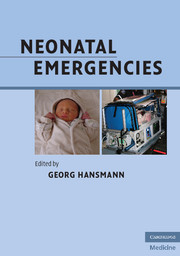Book contents
- Frontmatter
- Contents
- List of contributors
- Foreword (1)
- Foreword (2)
- Preface
- Acknowledgments
- Section 1 Organization of neonatal transport
- Section 2 Basics in cardiopulmonary resuscitation of newborn infants
- Basic equipment setup for initial neonatal care and resuscitation
- Drugs for neonatal emergencies
- Postnatal cardiopulmonary adaptation
- ABC Techniques and Procedures
- Sunctioning
- Stimulation, oxygen supplementation, bag-and-mask ventilation (M-PPV), pharyngeal/bi-nasal CPAP, and pharyngeal positive pressure ventilation
- Endotracheal intubation and gastric tube placement
- Laryngeal mask airway (LMA)
- Chest compressions
- Peripheral venous access
- Umbilical vein/artery catheterization (UVC, UAC)
- Central venous access (internal jugular vein)
- Intraosseous access
- Cord clamping
- Management of high-risk infants in the delivery room
- Monitoring in the delivery room and during neonatal transport
- Hygiene in the delivery room and during neonatal transport (infection control)
- When to call a pediatrician to the delivery room
- Checklist for the postnatal treatment of newborn infants
- Assigning individual duties in the delivery room
- Clinical assessment of the newborn infant
- Cardiopulmonary resuscitation of newborn infants at birth
- Volume therapy and sodium bicarbonate supplementation in preterm and term newborn infants
- Absolute and relative indications for neonatal transport and NICU admission
- Communication with mother and father
- Coordinating neonatal transport and patient sign-out to the NICU team
- Documentation and feedback after neonatal emergency transport
- Ethics in neonatal intensive care
- Perinatal images of preterm and term infants
- Mechanical ventilation of the neonate
- Questions for review (basics)
- References (Section 2)
- Section 3 Classic and rare scenarios in the neonatal period
- Section 4 Transport
- Section 5 Appendix
- Index
- Plate section
Laryngeal mask airway (LMA)
from Section 2 - Basics in cardiopulmonary resuscitation of newborn infants
Published online by Cambridge University Press: 05 March 2012
- Frontmatter
- Contents
- List of contributors
- Foreword (1)
- Foreword (2)
- Preface
- Acknowledgments
- Section 1 Organization of neonatal transport
- Section 2 Basics in cardiopulmonary resuscitation of newborn infants
- Basic equipment setup for initial neonatal care and resuscitation
- Drugs for neonatal emergencies
- Postnatal cardiopulmonary adaptation
- ABC Techniques and Procedures
- Sunctioning
- Stimulation, oxygen supplementation, bag-and-mask ventilation (M-PPV), pharyngeal/bi-nasal CPAP, and pharyngeal positive pressure ventilation
- Endotracheal intubation and gastric tube placement
- Laryngeal mask airway (LMA)
- Chest compressions
- Peripheral venous access
- Umbilical vein/artery catheterization (UVC, UAC)
- Central venous access (internal jugular vein)
- Intraosseous access
- Cord clamping
- Management of high-risk infants in the delivery room
- Monitoring in the delivery room and during neonatal transport
- Hygiene in the delivery room and during neonatal transport (infection control)
- When to call a pediatrician to the delivery room
- Checklist for the postnatal treatment of newborn infants
- Assigning individual duties in the delivery room
- Clinical assessment of the newborn infant
- Cardiopulmonary resuscitation of newborn infants at birth
- Volume therapy and sodium bicarbonate supplementation in preterm and term newborn infants
- Absolute and relative indications for neonatal transport and NICU admission
- Communication with mother and father
- Coordinating neonatal transport and patient sign-out to the NICU team
- Documentation and feedback after neonatal emergency transport
- Ethics in neonatal intensive care
- Perinatal images of preterm and term infants
- Mechanical ventilation of the neonate
- Questions for review (basics)
- References (Section 2)
- Section 3 Classic and rare scenarios in the neonatal period
- Section 4 Transport
- Section 5 Appendix
- Index
- Plate section
Summary
Current evidence
Masks that fit over the laryngeal inlet (i.e., LMA) are effective for ventilating newborn full-term infants (level of evidence (LOE) 2; LOE 5). There are limited data on the use of these devices in small preterm infants (LOE 5). There is currently no evidence directly comparing LMA with bag-valve-bag-and-mask (BMV) ventilation during neonatal resuscitation. Data from two case series show that use of the LMA can provide effective ventilation in a time frame consistent with current resuscitation guidelines (LOE 5). A single randomized controlled trial found no significant difference between the LMA and tracheal intubation during resuscitation of babies by experienced providers after cesarean section (LOE 2). Case reports suggest that when ventilation via a face mask has been unsuccessful and tracheal intubation is unsuccessful or not feasible, the LMA may provide effective ventilation (LOE 5). A well-designed randomized controlled trial comparing the LMA with BMV during neonatal resuscitation is warranted.
Indication
PPV with face mask (bag or T-piece resuscitator) fails to achieve effective ventilation, and attempts at endotracheal intubation are either not feasible or unsuccessful (“can't ventilate and can't intubate”). Examples are:
Congenital anomalies involving the mouth, lip, or palate, i.e., achieving a good seal with the bag and mask is difficult (head and neck cysts, cleft palate, Down syndrome, Beckwith–Wiedemann syndrome, Pierre Robin sequence, Treacher Collins syndrome, etc.)
Anomalies of the mouth, tongue, pharynx or neck, when there is difficulty visualizing the larynx with a laryngoscope (head and neck cysts, Down syndrome, Beckwith–Wiedemann syndrome, Pierre Robin sequence, etc.)
A very small mandible or relatively large tongue (e.g., Pierre Robin sequence, Beckwith–Wiedemann syndrome, Down syndrome, etc.)
- Type
- Chapter
- Information
- Neonatal Emergencies , pp. 96 - 100Publisher: Cambridge University PressPrint publication year: 2009



